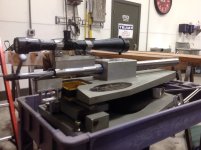jackie schmidt
New member
You have done quite a bit of testing with torque on barrel block bolts, seeing just how much you can apply before you can feel the ID collapse with a lead lapping plug.
What's your conclusions. This is a typical 6 inch long block, ten 5/16 socket head cap screws, 1.450 barrel, ( turned dead straight to 1.440 in way of block), non metallics bushing, 1/4 wall thickness.
I have taken the effort to actually mount the scope on the action, so if anything could possibly shift, the scope is on the barreled action, just like a regular rifle.
http://benchrest.com/attachment.php?attachmentid=17886&stc=1&d=1464881593
http://benchrest.com/attachment.php?attachmentid=17887&stc=1&d=1464881766
What's your conclusions. This is a typical 6 inch long block, ten 5/16 socket head cap screws, 1.450 barrel, ( turned dead straight to 1.440 in way of block), non metallics bushing, 1/4 wall thickness.
I have taken the effort to actually mount the scope on the action, so if anything could possibly shift, the scope is on the barreled action, just like a regular rifle.
http://benchrest.com/attachment.php?attachmentid=17886&stc=1&d=1464881593
http://benchrest.com/attachment.php?attachmentid=17887&stc=1&d=1464881766
Attachments
Last edited:



